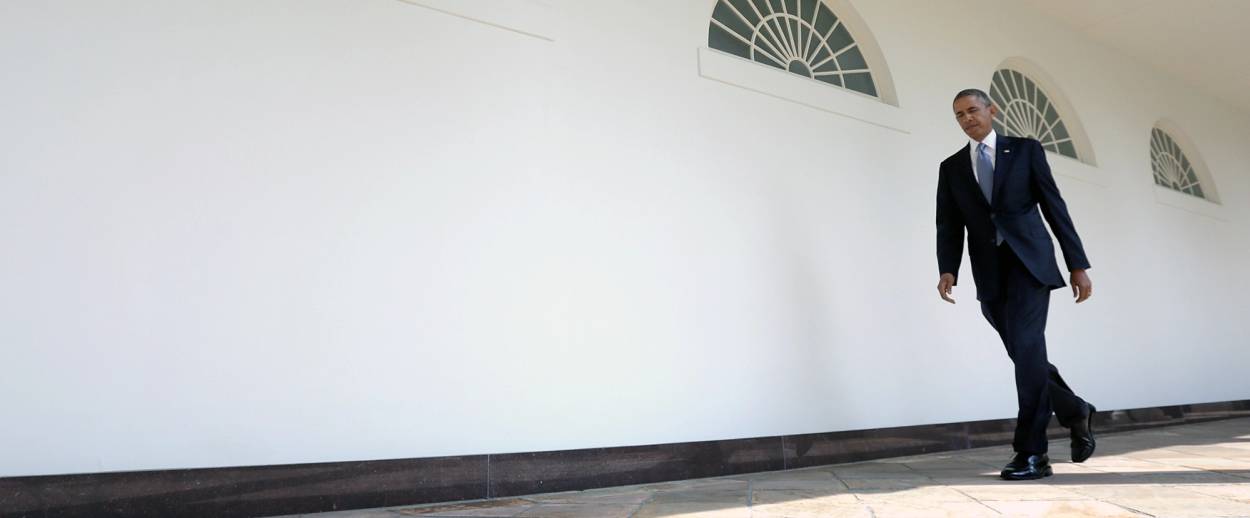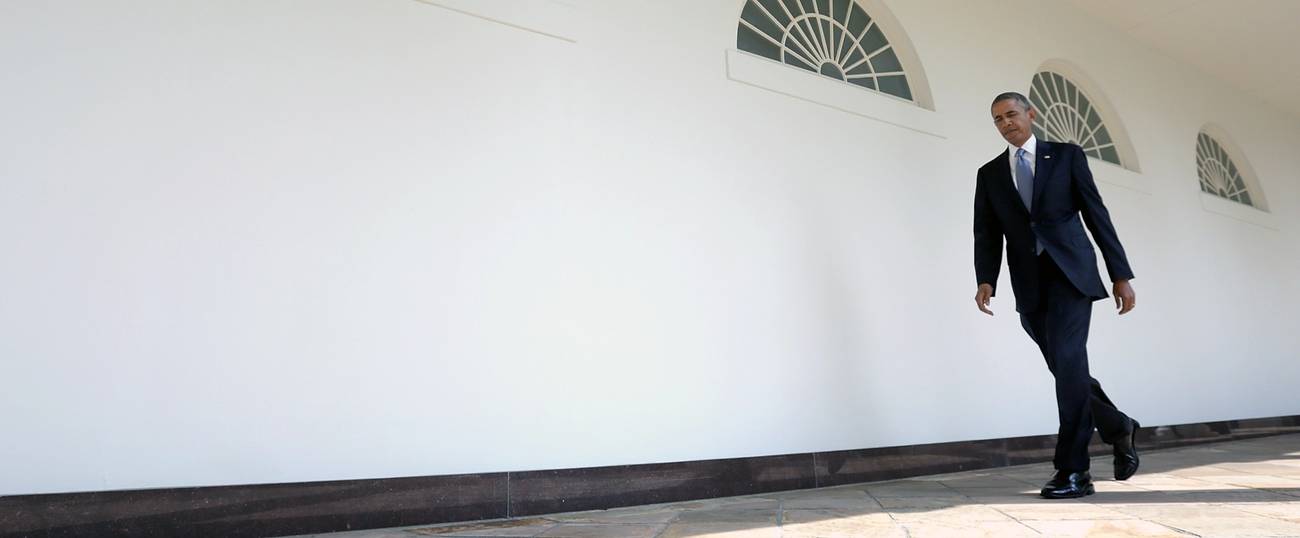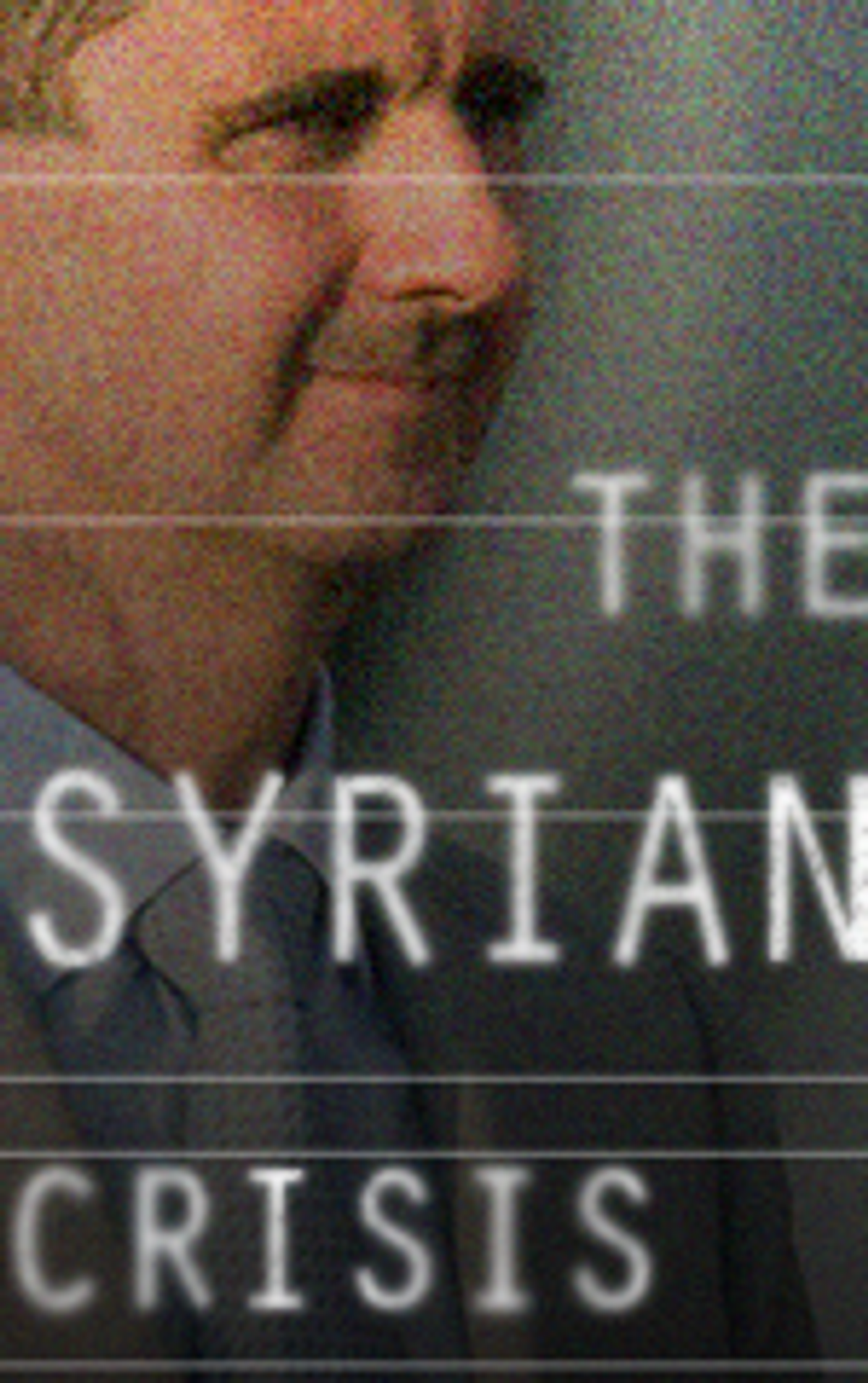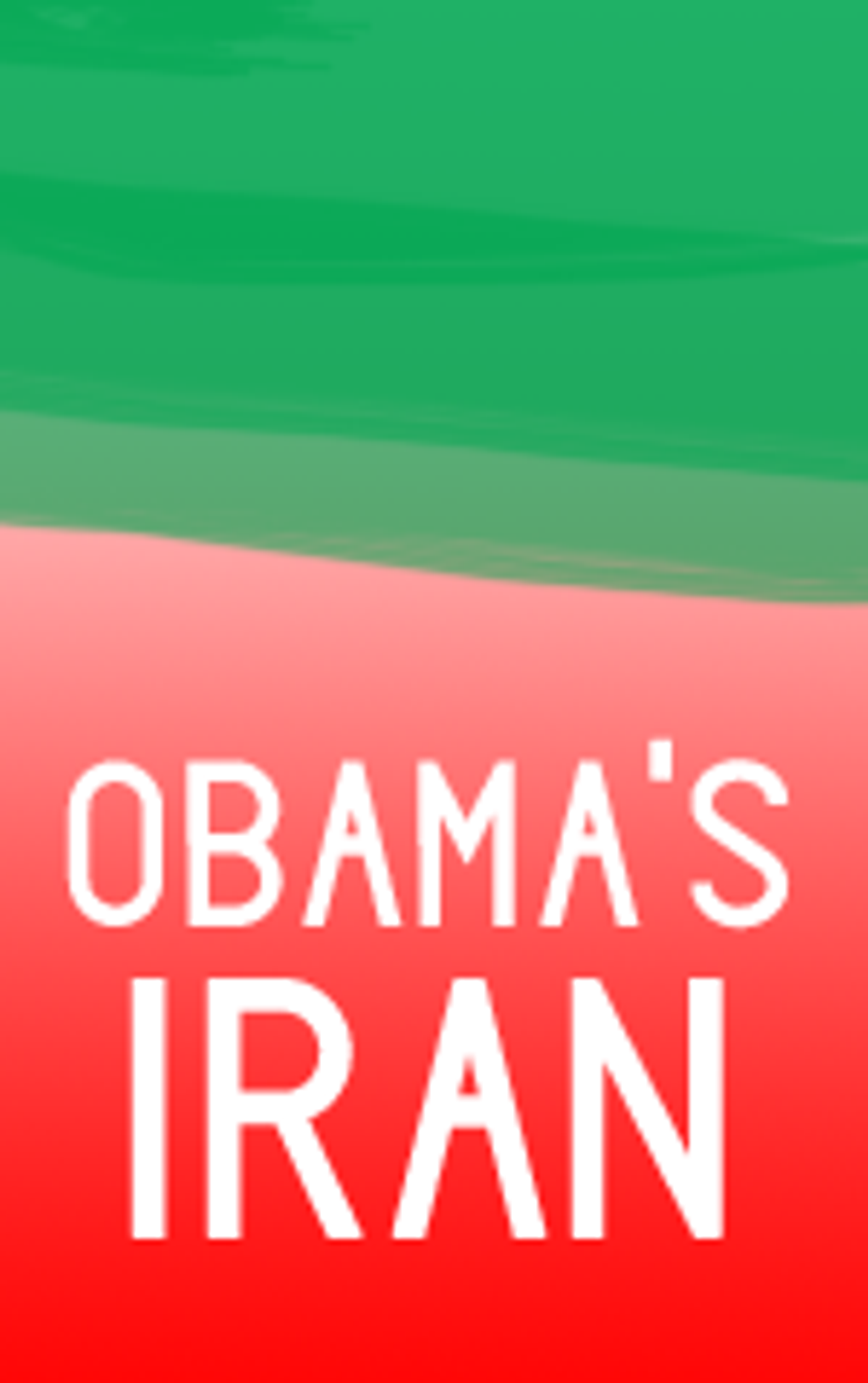Obama’s Syria Policy Striptease
America’s Moral Collapse in Syria: Why hasn’t the administration done anything about Syria, and won’t? Because the Iran Deal.




America’s settled policy of standing by while half a million Syrians have been killed, millions have become refugees, and large swaths of their country have been reduced to rubble is not a simple “mistake,” as critics like Nicholas D. Kristof and Roger Cohen have lately claimed. Nor is it the product of any deeper-seated American impotence or of Vladimir Putin’s more recent aggressions. Rather, it is a byproduct of America’s overriding desire to clinch a nuclear deal with Iran, which was meant to allow America to permanently remove itself from a war footing with that country and to shed its old allies and entanglements in the Middle East, which might also draw us into war. By allowing Iran and its allies to kill Syrians with impunity, America could demonstrate the corresponding firmness of its resolve to let Iran protect what President Barack Obama called its “equities” in Syria, which are every bit as important to Iran as pallets of cash.
And just like it sold its Iran policy through a public “echo chamber” of paid “experts” from organizations like Ploughshares and quote-seeking journalists and bloggers, some of whom also cashed White House-friendly nonprofit checks, the White House deliberately constructed an “echo chamber” to forward its Syria policy. The difference between the two “echo chambers” is that, absent any wider debate or the need for congressional approval, the Syria version was much more narrowly targeted at policy wonks and foreign-affairs writers, and the arguments it echoed were entirely deceptive in their larger thrust—the point of the Iran Deal was, in fact, to do a deal with Iran—rather than simply incomplete or false in their specifics.

America’s Syria policy can, therefore, be best understood not in the terms most familiar to Mideast analysts, such as “getting Assad to step aside” or “supporting the moderate opposition” or “paving the way to a peaceful transition and elections.” Rather, it is a strategic-communications campaign tightly run from the White House, whose purpose was and is to serve as a smokescreen for an entirely coherent and purposeful policy that comes directly from the president himself, but which he and his aides did not wish to publicly own. The goal of the president and his closest aides is to convince the Iranians that we would meet our commitments to them while confusing and obscuring the real reasons behind the president’s set decision of nonintervention in Syria from American legislators and the public alike.
Recently, portions of the strategic-communications façade erected by the administration have started to crumble, allowing interested analysts and members of the public to see the administration’s actual policy more clearly. In a recent interview, Wall Street Journal reporter Jay Solomon revealed that in 2013, Iran told President Obama that if he were to strike the regime of Bashar Assad following the latter’s chemical-weapons attack, the Iranians would collapse the talks over their nuclear program. Obama canceled the strike, of course, and later reassured Iran that the United States would not touch Assad. Solomon’s reporting confirms a critical fact about Obama’s Iran and Syria policies: They are one and the same. Or, stated differently, Syria is part of the price for the president’s deal with Iran.
The White House reaction to Solomon’s assertion was a predictably swift denial. After all, the Obama administration would not want to associate the president’s signature foreign-policy initiative with the indiscriminate slaughter of half a million people and the worst refugee crisis of the new century. In doing so, it followed a well-worn playbook: At key junctures over the previous five years, the administration put out various talking points in the press, often sourced to anonymous officials, whose lines were then validated by allies and surrogates, including officials who had left government and resumed their positions in the think-tank world. As previously, the president’s objective was to manage domestic and allied pressure to intervene when his unmovable position was to avoid such an engagement at all costs, and always with an eye on the prize he sought in Tehran.
To be fair, Obama showed his cards on Syria literally from day one of the uprising against Assad. Unlike his nonnegotiable demand that longtime U.S. ally Hosni Mubarak, Egypt’s former president, step down immediately—not today, but “yesterday”—Obama very visibly and deliberately refused to call for Assad’s removal from power. In the White House, this call was contemptuously dubbed the “magic words,” and the belief was that saying those words would raise expectations of an active U.S. policy to see it through. This view—espoused by officials such as Steven Simon, then-National Security Council senior director for the Middle East and Africa—one of the linchpins of the White House communications strategy both from inside and then outside the White House, was put out in the media through favored surrogates, like George Washington University’s Marc Lynch, who reiterated the White House’s case and derided critics of the president’s refusal to utter the “magic words.”
If Obama purposefully took the Iranian regime’s side during the 2009 protests so as not to upset the prospect of rapprochement, he similarly wasn’t about to commit the United States against Iran’s longest-standing strategic ally, Assad. However, by 2012, criticism of the administration’s policy had grown more vocal, and calls rose to give military support to the Syrian opposition, a proposition the president was always opposed to. As this was a fixed position for Obama, the task before the White House was, therefore, one of public relations—to quiet the calls for supporting the opposition, outside and also within the administration, without doing anything that would actually upset Assad and his patrons in Iran.
Messaging, as always, was of paramount importance to the White House. As The Wall Street Journal reported in early 2013, “White House national security meetings on Syria [in 2012] focused on what participants called ‘strategic messaging,’ how administration policy should be presented to the public.” To that end, the administration started putting out targeted talking points. The administration laid down its now-infamous mantra: There is no military solution in Syria.
One of the initial go-to lines was that the administration wanted to avoid further “militarization” of the situation. “We do not believe that militarization, further militarization of the situation in Syria at this point is the right course of action,” said then-White House press secretary Jay Carney. “We believe that it would lead to greater chaos, greater carnage.”
Again, White House surrogates faithfully disseminated its talking points and policy preferences. In an article in February of 2012, Washington Post columnist David Ignatius quoted an unnamed senior official who derided the rebel Free Syrian Army, then regurgitated the administration’s view that “shoveling weapons to this disorganized opposition now is likely only to increase civilian deaths.” Marc Lynch likewise repeated the administration’s position, often using its own stock lines verbatim, in several articles for Foreign Policy and in a paper for the Center for a New American Security.
Assad’s fall was inevitable, the administration contended. His days were numbered, and his departure, as Obama put it, was “not a question of if, it’s when.” As such, it wasn’t necessary to take military action against Assad. The White House cited intelligence indicating that Assad could be killed by his own people, “eliminating the need for riskier measures to support the rebel campaign.” “There are people around Assad who are beginning to hedge their bets,” asserted then Secretary of State Hillary Clinton. There might be a coup in Syria, she predicted. “We saw this happen in other settings last year; I think it is going to happen in Syria.” Obama’s close aide Denis McDonough instructed the administration committee charged with Syria policy instead to “focus mostly on post-Assad planning,” because the dictator’s fall was simply a matter of time.
In fact, by summer 2012, when the White House was already running its secret talks with Iran in Oman, the Syria “small group”—the study group led by Simon, which had called on Obama to review military contingencies—had been shut down.
To shore up the noninterventionist position it had already guaranteed the Iranians, the White House introduced the enduring fixture of its Syria policy: bringing in Russia as a principal partner. The move coincided with the creation of the Friends of Syria group—intended to bypass Russian obstructionism at the U.N. Security Council. Obama then undercut this group of U.S. allies by instead drawing closer to Russia.
Working to accelerate Assad’s fall, the White House messaged, “could undercut U.S. efforts to persuade Russia to halt military aid to the Syrian regime.” Marc Lynch echoed the line in his CNAS paper: “It would also be very difficult to stop Russia, Iran, or others from supplying fresh arms and aid to Assad once the opposition’s backers are openly doing so.” Meanwhile, the Washington Post’s David Ignatius seconded the administration’s move “to make Moscow part of the solution,” and give “Russian leader Vladimir Putin a role in brokering the transition.” If people wanted a solution to the Syrian problem, the White House argued, they should go and talk to the Russians. “So the question shouldn’t be how to turn up the heat on Assad,” Ignatius wrote. Rather, U.S. regional allies should do “the heavy-lifting,” and go to Moscow. Having established the principle of nonintervention and set the role of Russia as principal interlocutor for the region, the White House set the contours of America’s actual Syria policy, which endure unchanged to this day.
The partnership with Russia became a public fact in 2013. Following Assad’s chemical-weapons strikes, Obama reached a deal with Putin that allowed the U.S. president to continue his policy of nonintervention against Assad. At this point, White House messaging made a 180-degree shift. Obama’s decision, administration officials readily acknowledged, meant Assad—who, a year before, they said was about to fall at the hands of the people or as the result of a coup—now had “considerable staying power.” It was, therefore, too bad, other administration officials said, that “the window of opportunity for strengthening the moderate opposition may have closed.”
Instead, administration officials started telling reporters on background that no outside support would have mattered, anyway, as the gap between America and the Syrian regime and its allies was simply too big to ever have been bridged. The president himself would publicly voice this position, declaring the notion that supporting the rebels—“former doctors, farmers, and pharmacists,” as the president disparagingly referred to them—would have made a difference against a regime backed by Russia and Iran, has “always been a fantasy.” To suggest otherwise, the president said, was “horseshit.”
Like the assertions of 2012, these claims, presented as serious assessments of the situation on the ground in Syria, were simply part of a White House messaging campaign, whose purpose was to support a policy that was already set—but which the public was judged not to be ready for. That the arguments the administration was making were paradoxical and contradictory didn’t matter, so long as the point was the same: America wouldn’t and couldn’t intervene against Assad. Naturally, surrogates like Lynch echoed the administration’s arguments, even when they changed, and also felt at home in the contradictions of their positions. “There’s no way to know for sure” whether U.S. support in 2012 would have made a difference, Lynch would later write. In fact, he asserted, things would’ve played out exactly as they have, with the only difference that the United States would’ve been in the middle of the fighting.
By the end of 2013, the White House began to mainstream its open disregard for even the pretense of removing Assad, thereby circling back to its initial position in 2011. Unnamed senior administration officials were cited as talking privately about Assad “staying for the foreseeable future” and “voic[ing] regret about the decision, in August 2011, to call for him to step aside.” In early 2014, Frank Wisner of The Iran Project and Leslie Gelb, both veterans of the realist foreign-policy establishment, were chosen to carry this White House message to members of the Council on Foreign Relations and other thumb-sucking senior types. The president and officials at the White House, Wisner and Gelb wrote, realized “it was too quick off the mark and too absolute” in calling for Assad’s departure. “Perhaps now,” they added, “administration officials are prepared to entertain a transitional working arrangement with Assad.” The new focus for U.S. policy, the authors wrote, should be on combating Sunni terrorism and on providing humanitarian aid to Syrians. Amazingly, much like the expert advice not to intervene militarily in 2012, what Wisner and Gelb were “recommending” was the actual substance of White House policy, which the communications effort had formerly been designed to obscure.
The form of Wisner and Gelb’s article became the preferred genre for the White House’s Syria echo chamber: the striptease. Hand-picked experts offer fresh policy advice to the president. The authors demonstrate their independence by criticizing the supposed current policy and propose a new course of action. Within weeks, the new course of action is acknowledged as policy, thus flattering the importance of the experts. Only, what the experts suggested was already the policy—and what they were “criticizing”—was the fan that the messaging campaign had manufactured to obscure, for a time, what the White House was actually doing in Syria.
The success of this dance was great enough that many more proposals for “new” policy, all recycling the White House’s latest set of talking points, were floated, each with the aim of revealing another few inches of actual policy. Simon, who was now out of government, put forward a “new plan for Syria,” in which he called for “containing extremist violence” and “reducing the number of noncombatant deaths.” One month later, Lynch published another paper with CNAS, in which he reproduced all the key White House talking points used to describe its policy to this day, debuting terminology, like “de-escalation” and “protecting Iranian equities,” which was then promptly adopted by the White House.
Both Simon and Lynch floated the idea of promoting local cease-fires—now a mainstay of the White House’s declared policy—as the way to go in Syria. Again, they were not so much promoting views that were original to them but promoting a pre-existing conceit, whose actual sponsor, Robert Malley, was appointed in February 2014 as a senior director at the National Security Council, where he worked alongside Phillip Gordon, who came in the year before as coordinator for Middle East policy.
By following in Malley’s footprints, it is easy to see where specific ideas came from, and the corrupted nature of the policy debates that were used by the White House to promote its set agenda. For example, Malley met in Washington with journalist Nir Rosen, who has a close relationship with the Assad regime. Following his meeting with Malley, Rosen authored an unpublished pro-Assad report making the case for local cease-fires—which have been an instrument of warfare for the regime camp. Malley distributed Rosen’s report, which, naturally, was also leaked to David Ignatius. Simon’s and Lynch’s pieces floated the approach favored by Malley and the White House in much cleaner form and venues than the tarnished Rosen.
It was all very useful, and chummy, and everyone scratched everyone else’s back, until the ISIS crisis blew up and disrupted the Syria messaging campaign by making the administration, which decided it could dismiss the latest jihadi faction as “the JV squad,” look feckless. As it happened, ISIS would turn out to have its benefits as a messaging device. It, too, could be used as part of the fan-dance.
***
The emergence of ISIS presented an opportunity for the White House to advance the president’s vision of a regional realignment. Under the rubric of a new war on Sunni jihadism, the president elevated Russia and Iran to senior partners, and privileged their position, while shelving all discussion about Assad. What had been secret and a cause for strenuous denials was now palatable state policy, which the White House could therefore publicly own.
Hence, Simon, reflecting the direction of White House policy in the guise of fresh advice, proclaimed the United States should start discussing Syria with Iran in order to have “the best chance of long-term success.” Similarly, Marc Lynch proposed the White House adopt “an alternative Iran-centric approach, one built upon seeking a working accord with Iran rooted in common interests in … stabilizing Iraq and Syria, and fighting jihadist groups.” In addition, like Wisner, Gelb, and Simon had all written earlier, Lynch echoed the White House by calling for sacrificing the “goal of ‘near-term’ regime change” in Syria.
Following the White House’s standard operating procedure, anonymous administration officials had already been leaking all these talking points to the press during the course of 2014. For instance, in July of that year, it was reported that administration officials were proposing setting aside the removal of Assad from power. “Anyone calling for regime change in Syria is, frankly, blind to the past decade,” one unnamed senior official told The Daily Beast. Other officials were “suggesting that Iran could be a partner in a postwar Syria.” When Lynch spoke of “us[ing] the ISIS crisis to create a sustainable regional accord,” he was therefore merely putting his own name to statements that the White House had already publicly vetted.

Formalizing Tehran’s place at the table in Syria, as Obama had promised the regime, would have to wait for the conclusion of the Joint Comprehensive Plan of Action (JCPOA) in 2015. Once that was achieved, Russia understood the door was open to intervene directly in Syria. A couple of months after the deal was concluded, the Russians set up their military base in Syria.
Obama’s Syria policy once again came under criticism following the Kremlin’s move. The president looked weak in the face of Russian assertiveness on behalf of its ally. The White House’s initial messaging was therefore to paint the Russian intervention as an idiotic decision that would inevitably backfire on Moscow. Putin’s intervention reflected weakness, not strength, the president maintained. As such, the preferred White House talking point was that Russia was only getting itself trapped in a quagmire. “An attempt by Russia and Iran to prop up Assad and try to pacify the population is just going to get them stuck in a quagmire, and it won’t work,” Obama said in early October.
These lines were quickly put out in friendly media outlets. The Brookings Institution’s Jeremy Shapiro, who had worked for Philip Gordon at the State Department before the latter moved to the White House, enthusiastically regurgitated the administration’s approved talking points in an interview with Vox also in early October. Shapiro repeated the claim that the Russian intervention was “incredibly stupid stuff,” a “serious mistake,” and, naturally, that it would get Moscow into a “quagmire.” The Russians, Shapiro declared, were “banking on this idea that they’re going to bring us around” on Syria. But, he asserted, “I don’t think they are.”
As the White House pushed these talking points about how dumb Putin was, it also continued to stress the president’s unshakable principle of nonintervention. “We’re not going to make Syria into a proxy war between the United States and Russia,” Obama made clear. “This is not some superpower chessboard contest.” Anyone suggesting military options, the president continued, was simply “offering up half-baked ideas” and “a bunch of mumbo-jumbo.”
Philip Gordon, now also out of government, was a notable conduit for the main talking points: de-escalation, cease-fires, humanitarian aid, and shelving the question of Assad. “The White House,” one senior administration official—the point man for Syria at the time, and now, is Robert Malley—told Bloomberg View in early October, “thinks we can de-escalate the conflict while keeping Assad in power.” Gordon, Malley’s recent colleague at the NSC, and now a freshly minted fellow at the Council on Foreign Relations, then laid out this White House position in an essay and a paper for the CFR, which fall into the familiar genre of validating current policy in the guise of “rethinking” it. He also echoed the White House’s direction of bringing Iran formally to the Syria table as a major stakeholder. More aid to the rebels, he opined, would only add to the violence and would harm prospects of a deal with Russia. Escalating the war, Gordon wrote, wouldn’t succeed. In fact, it was counterproductive. However much we escalate, the Russians would only counter-escalate. When would the bloodshed ever cease?
Through Gordon, the White House laid out where it wanted to go, and where it is today: a bilateral process with the Russians, cutting out all those annoying U.S. allies pushing us to escalate and insisting on Assad’s departure. Hence, Steven Simon, now also a freshly-minted objective policy expert and not an NSC operative, would express “satisfaction” at the presence in Syria “of a powerful military player” like Russia, which he described as “really the only tacit partner” of the United States. The Russian presence, Simon wrote in a Foreign Affairs essay that October, makes it “no longer feasible for the United States to establish a safe haven or no-fly zone”—steps the administration had strongly opposed years before the Russians were anywhere near Syria. Critics of Obama’s policy who were calling for any consideration of military action, the message went, could take a hike.
None of this is conjecture. Partnership with Russia is what the White House has sought after since late 2015 and throughout 2016—with Malley as the point man, negotiating directly with the Kremlin’s special envoy. By early 2016, Shapiro, who had parroted the White House’s misguiding spin on the incredible stupidity of the Russians’ intervention, was now saying the Russians actually held all the cards in Syria, and the only option for the U.S. is to work with them, on their terms. What’s more, echoing Malley, Shapiro laid out the White House position on the need to finally take military action—against the group then known as Jabhat al-Nusra, and to push (meaning, to threaten) the opposition and its backers to stop all cooperation with it, if the killing was to stop in Aleppo. This was, in fact, the deal that Malley negotiated for the White House, and which Secretary of State John Kerry announced several days ago.
For five-and-a-half years, Obama has maintained an unwavering position against intervention on the side of Assad’s enemies in order to set the stage for a U.S. realignment in the Middle East. To shield this ambition from view, and therefore from criticism, the White House launched an elaborate spin campaign whose purpose was to deflect and manage domestic and allied criticism while the president pursued his objective. In partnership with Russia, Obama has directly shaped the course of the Syrian war while single-mindedly working to actualize his vision of a new American alliance with Russia and Iran that will allow America to take a permanent vacation from the Middle East. While the end result of this effort may not be what Obama and his closest advisers hope, his actions are clear, and their consequences now appear to be locked in, no matter who comes after him in the White House.
***
Like this article? Sign up for our Daily Digest to get Tablet Magazine’s new content in your inbox each morning.
Tony Badran is Tablet’s news editor and Levant analyst.